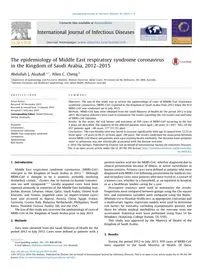
2016 The epidemiology of Middle East respiratory syndrome coronavirus in the Kingdom of Saudi Arabia, 2012_2015 PDF
Preview 2016 The epidemiology of Middle East respiratory syndrome coronavirus in the Kingdom of Saudi Arabia, 2012_2015
The epidemiology of Middle East respiratory syndrome coronavirus in the Kingdom of Saudi Arabia, 2012–2015 Abdullah J. Alsahafi a,*, Allen C. Cheng b a Department of Epidemiology and Preventive Medicine, Monash University, Alfred Centre, 99 Commercial Rd, Melbourne, VIC 3004, Australia b Infection Prevention and Healthcare Epidemiology Unit, Alfred Health, Melbourne, Australia 1. Introduction Middle East respiratory syndrome coronavirus (MERS-CoV) emerged in the Kingdom of Saudi Arabia in 2012.1,2 Although MERS-CoV is thought to be a zoonosis, probably involving dromedary camels,3 clusters due to human-to-human transmis- sion are well recognized.4–6 Locally acquired cases have been reported primarily in countries of the Middle East including Iran, Jordan, Kuwait, Lebanon, Oman, Qatar, Saudi Arabia, United Arab Emirates, and Yemen; imported cases (or import-related cases) have also occurred in Algeria, Austria, China, Egypt, France, Germany, Greece, Italy, Malaysia, Netherlands, Philippines, South Korea, Thailand, Tunisia, Turkey, UK, and the USA.7 The aim of this study was to review the epidemiology of cases of MERS-CoV in the Kingdom of Saudi Arabia prior to July 2015. 2. Methods Data were obtained from the Saudi Ministry of Health for the period 2012 to July 2015. Cases were defined as patients with a positive nucleic acid test for MERS-CoV, whether diagnosed due to clinical presentation because of illness, or active surveillance in known contacts. Primary cases were defined as patients who were diagnosed with MERS-CoV following presentation for medical care, and secondary cases were patients who were tested as a contact of a known case, whether in a household, as an inpatient in hospital, or as a healthcare worker caring for a case. Descriptive statistics were used to summarize the results. Proportions were compared between groups using the Chi-square test, and continuous variables were compared using the Mann– Whitney test or Kruskal–Wallis test, as appropriate. Univariate and a multivariate logistic regression models were used to determine risk factors for mortality, excluding asymptomatic patients and those for whom medical morbidities or the outcome were not ascertained. Statistical tests were performed using Stata 14 for Windows (StataCorp, College Station, TX, USA). This study was approved by the Ministry of Health of the Kingdom of Saudi Arabia. 3. Results During the period 2012 to July 2015, 939 cases of MERS-CoV were reported to the Saudi Ministry of Health. Of these, International Journal of Infectious Diseases 45 (2016) 1–4 A R T I C L E I N F O Article history: Received 16 December 2015 Received in revised form 13 January 2016 Accepted 5 February 2016 Corresponding Editor: Eskild Petersen, Aarhus, Denmark. Keywords: Coronavirus Coronavirus infections Middle East respiratory syndrome coronavirus Epidemiology Risk factors S U M M A R Y Objectives: The aim of this study was to review the epidemiology of cases of Middle East respiratory syndrome coronavirus (MERS-CoV) reported in the Kingdom of Saudi Arabia from 2012 when the first MERS-CoV was confirmed up to July 2015. Methods: MERS-CoV data were obtained from the Saudi Ministry of Health for the period 2012 to July 2015. Descriptive statistics were used to summarize the results regarding the risk factors and mortality of MERS-CoV infection. Results: In this series, the risk factors and outcomes of 939 cases of MERS-CoV occurring in the last 3 years are described. The majority of the affected patients were aged �40 years (n = 657; 70%). Of the 657 patients aged �40 years, 377 (57.3%) died. Conclusions: The case-fatality ratio was found to increase significantly with age. It ranged from 12.5% in those aged �19 years to 86.2% in those aged �80 years. The results confirmed the association between severe MERS-CoV illness and patients with a pre-existing health morbidity. The duration from symptom onset to admission was not statistically associated with the disease outcome. � 2016 The Authors. Published by Elsevier Ltd on behalf of International Society for Infectious Diseases. This is an open access article under the CC BY-NC-ND license (http://creativecommons.org/licenses/by- nc-nd/4.0/). * Corresponding author. Tel.: +61 406548300. E-mail address:
